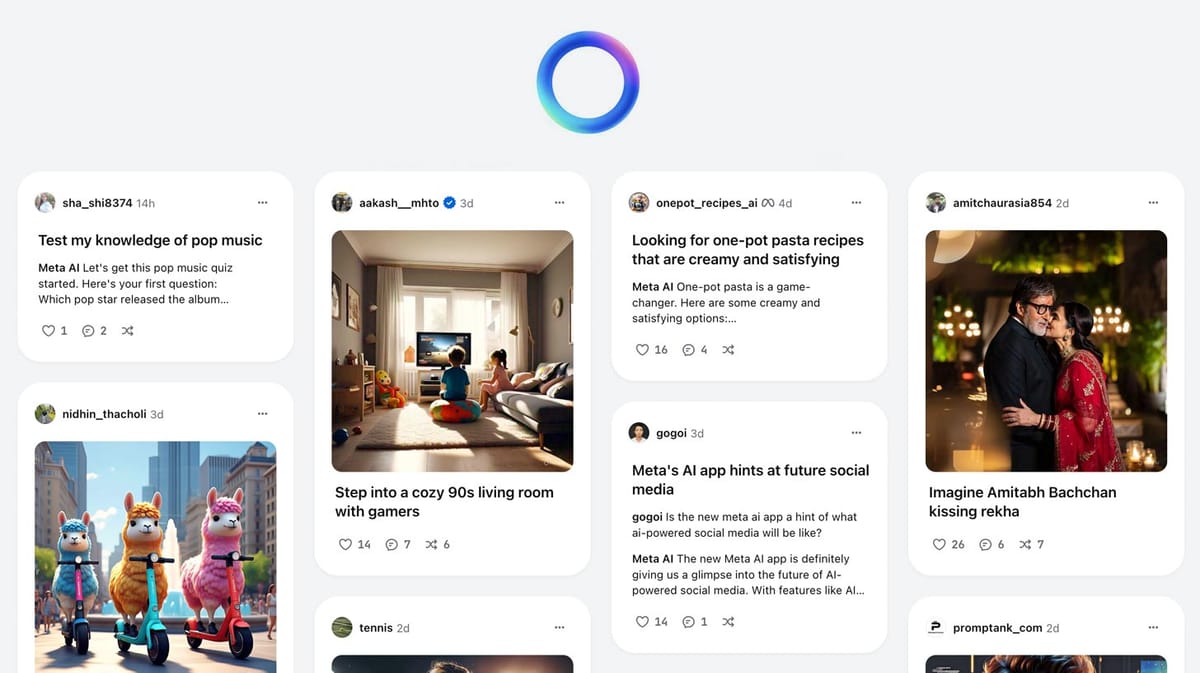Is Meta.ai the Future of Social Media?
The "Discovery" feed in Meta's standalone app is redefining generative AI and social media as the two worlds inevitably converge.

Last week, Meta pushed its new standalone AI app into the wild, complete with a Discovery feed that looks and feels like Instagram for prompts. The announcement unveiled a new opt-in feature that might just be the perfect marriage of AI and social media. Any conversation with the chatbot can now be published to a public feed where other users can scroll, like, comment, or remix the original prompt and tweak it into something new.
Amanda Silberling, reporting for TechCrunch, stresses that the sharing feature is optional, meaning your conversations stay private unless you choose to publish them. Yet the interface is unmistakably social as a string of chats invite endless scrolling through generative images, video clips, and prompts. The experience is tailored to your interests, fed by your "friends" on Meta's other social platforms and informed, of course, by hordes of your personal data the tech giant has squirreled away.
With each chat in the feed you'll find familiar profile avatars. Tap an author's pic and you'll land on their profile page, complete with a collection of their shared conversations. If you've spent any time on Instagram, it'll feel like déjà vu. But at the same time, this is entirely new.
The Feed as a Flywheel
Meta’s pitch is inspiration. Show people what's possible inside the model, spark experimentation, create a virtuous circle of content and curiosity. A more candid translation, however, is data. Every public prompt arrives pre-labeled with the user’s intent and the model’s response. It's training gold. The larger the network, the richer the feedback loop, the faster the model improves. And few companies command a bigger network than Meta.
Midjourney’s Precedent
Meta is hardly the first to notice that generative AI behaves differently once it enters a crowd. Midjourney has long relied on a public display of generative images that doubles as an idea factory. From its humble beginnings on Discord to the polished user experience on the new Midjourney site, a stream of "look what other people created" has been the key to dwell time, experimentation, and community building. Meta’s Discovery feed borrows the concept and grafts a full social stack on top. Not just likes, comments, and profiles, but the promise of reach.
A widening race
Competitors are moving in the same direction. The Verge reported that OpenAI has an internal prototype that resembles X, complete with a scrolling gallery of ChatGPT-generated images. X itself already pipes replies from its Grok chatbot straight into users’ timelines, folding AI into the social stream by default.
The rivalry between Sam Altman and Elon Musk has deep roots, dating back to Musk's early involvement and subsequent departure from OpenAI, fueling years of public sparring. Yet, while these two visionaries fixated on each other, Mark Zuckerberg quietly entered the arena, positioning Meta as perhaps an even bigger threat in this unfolding race to merge the stickiest network with AI. But it's not just about the high-profile CEOs.
Where strategy goes, talent follows. Alex Kantrowitz of Big Technology recently highlighted a hiring shift in which alumni of Facebook, Snapchat, and Pinterest have resurfaced at Anthropic, Perplexity, and OpenAI, bringing with them years of social media growth mojo. The migration suggests that building a large language model is no longer just a research problem. It's also a customer problem. And the network effect could be the wild card that turns masses of casual AI tinkerers into hard core users.
Implications for Brands
For marketers, the Discovery feed opens three fronts of opportunity and risk.
First, earned reach may shift. Clever prompt chains shared early could gather organic visibility the way witty tweets once did.
Second, the data dividend is significant. Every remix reveals language, intent, and sentiment in real time, a form of continuous focus-grouping that costs nothing.
Third, the risk profile is already visible. Business Insider already found medical and legal queries drifting into the public stream, raising privacy flags that will resonate with any compliance team. Brands that test the feed will have to weigh novelty against the possibility of sensitive information surfacing in public.
Will users spend meaningful time scrolling through strangers’ chatbot exchanges, or will the feed collapse into memes and spam? Can Meta resist the temptation to insert ads between chats once attention reaches critical mass? Do prompt influencers emerge, selling sponsored “remix-ready” chains the way Instagram creators push link stickers? And if the feed turns toxic, spreading misinformation as quickly as Facebook groups once did, does Meta have the appetite to police it?
If AI and Social Media had a Baby...
It might look an awful lot like Meta.ai. A chat window stitched to a scrolling feed, powered by a model that learns from every scroll and click. It inherits the recombinant creativity of generative AI and the engagement mechanics of social media, a blend engineered to keep users talking, posting, and coming back for more. Whether that union matures into a new channel or stumbles over the same privacy pitfalls that haunt its parents may depend on how fast platforms, regulators, and brands absorb the lessons of the past.
One thing we can all be sure of: in an AI-first future, the biggest advantage will still be quality content. Whether it's delivered through a feed, a voice, a phone, or a pair of glasses. Without that, nothing else matters.






